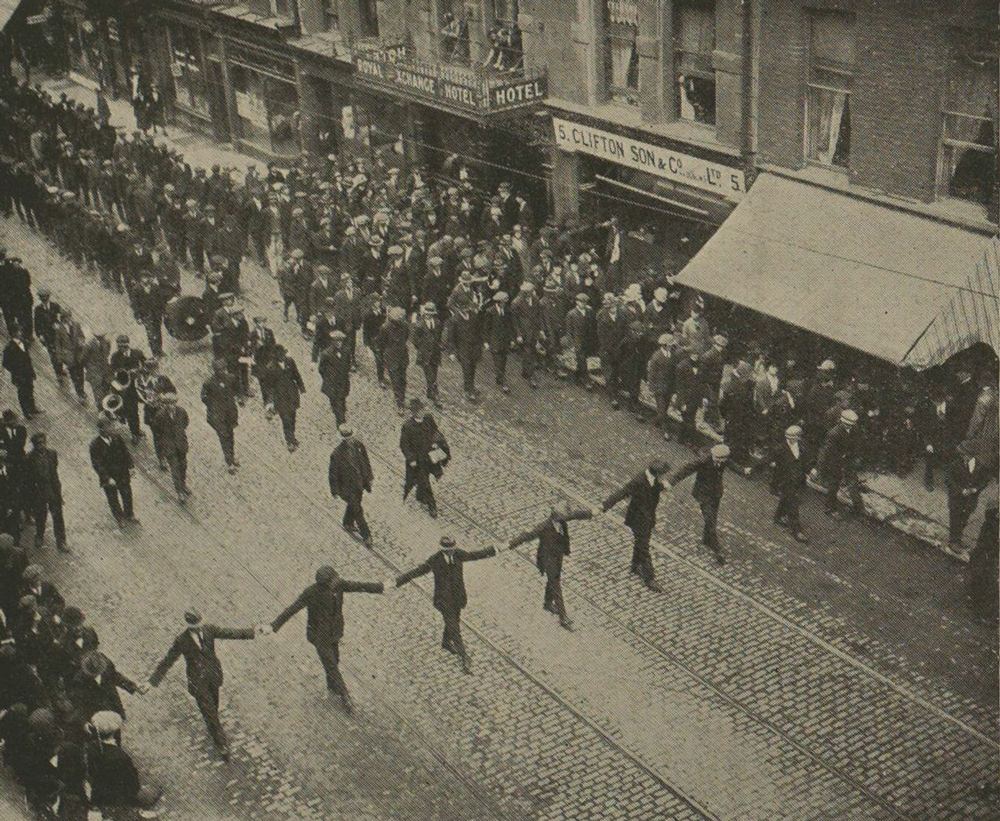Dubliner killed while attending welcome party for Archbishop Mannix
Dublin, 14 August 1920 - The funeral of Thomas Farrelly took place yesterday in Glasnevin Cemetery.
Farrelly, who was 20 years old and had an address at 30 Mary’s lane in Dublin City, was shot dead by the military while attending a bonfire on the night of 9 August. The inquest into his death concluded that Farrelly's killing was ‘without justification’. The verdict added its condemnation to the ‘action of the military in empowering youths to endanger the lives of citizens’.
His funeral mass took place in St Michan's Church in the city. At 2pm his remains were removed to Glasnevin cemetery. Thousands marched in the funeral cortege, and shops along the route closed as a mark of respect.

Scenes from Thomas Farrelly's funeral. Left: the coffin being carried to the hearse. Right: a wagon carrying a cross of flowers, bearing the inscription, 'Thomas Farrelly. Shot by the Military' (Image: Freeman's Journal, 14 August 1920)
The bonfire Farrelly was attending was lit, along with many others all over the country, to celebrate the anticipated arrival of Daniel Mannix, Archbishop of Melbourne, to Ireland.
Mannix, who was travelling from New York, was due to arrive in Queenstown, Co. Cork on 7 August. However, throughout the course of his journey, there was speculation as to whether or not this would be allowed to happen, in light of the British Prime Minister, David Lloyd George, having previously stated that the archbishop would not be allowed to land in Ireland. True to their word, the government sent two destroyers to meet the Baltic, the ship on which Mannix was travelling, preventing the ship from docking in Cork.
Initially it was suspected that the ship would be escorted to Liverpool, its intended destination after Queenstown, and a reception committee was set up there in order to welcome him. And though the Baltic did arrive there, Mannix was not on board. He had been taken off the ship in the middle of the night and onto one of the destroyers, the HMS Wivern, which took him to Penzance, where he landed on 9 August.
Archbishop Mannix immediately boarded a train to London, and on his arrival, spoke to a representative of the Press Association. He said that he had not been ill treated at any stage of the journey, but made it clear that he had been taken against his will. Speculating on the cause of the government's ‘hostility’ towards him, he claimed that they had not forgiven him for his vocal opposition to the introduction of conscription to Australia during the First World War.
Another reason he suggested was his defence of Ireland from ‘persistent and systematic vilification’, both in Australia and America: ‘It has been stated that I have made vigorous comment in America of the relations between England and Ireland. If I have, they were well deserved, and I stand by every word and syllable’.
Archbishop Mannix concluded the interview by saying that he did not consider himself bound by any government, but hadn’t yet decided if he would defy the order not to visit Ireland.
[Editor's note: This is an article from Century Ireland, a fortnightly online newspaper, written from the perspective of a journalist 100 years ago, based on news reports of the time.]





















